Jos olet laskeutunut tähän artikkeliin, mielestäni on turvallista sanoa, että sinä (tai pelaajasi) olet kiinnostunut osaamaan lentää jääkiekkovarusteillasi.
Ehkä olet jo valmis lentämään ulkomaille jääkiekkoa varten (esim. kaudeksi, turnaukseksi) ja haluat vain varmistaa, että sinulla on kaikki sorsat peräkkäin suunnittelun kannalta.
TAI
Ehkä vielä tutkit ajatusta jääkiekon pelaamisesta jossain ja haluat ymmärtää paremmin, miten tämä prosessin osa toimii.
Tässä artikkelissa annamme sinulle paljon sisäpiiritietoa ja tietoa ensikäden kokemuksemme perusteella.
Koska useat yhteistyökumppanimme ovat lentäneet ulkomaille monta kertaa entisinä ammattilaispelaajina ja olemme sittemmin auttaneet lukemattomia pelaajia lentämään ulkomaille jääkiekkovarusteiden kanssa (usein ensimmäistä kertaa) yli vuosikymmenen ajan... olemme sopineet hyvin käsittelemään aihetta.
Kirjoitamme tämän teoksen lähinnä Pohjois-Amerikasta lentämisen näkökulmasta <-> Euroopasta, koska meillä on laaja kokemus pelaajien auttamisesta pelata ammattilaisjääkiekkoa ulkomailla Euroopassa- mutta 90% alla olevista tiedoista, joita jaamme kanssasi, voidaan soveltaa suoraan matkustamiseen missä tahansa kansainvälisesti jääkiekkovarusteiden kanssa.
Sisällysluettelo:
- Jääkiekon valmistelu ennen matkaa
- Jääkiekkovarusteet/laukun paino
- Lentoyhtiön valinta
- Lentoyhteysaikojen merkitys
- Matkapäivä (jääkiekkovarusteiden kanssa)
- Passin, maahanmuutto ja kansainvälisen laukun uudelleentarkastus
- Laskeutuminen + jääkiekkovarusteiden noutaminen
- Mitä tehdä, jos jääkiekkovarusteet viivästyvät
- Johtopäätös
Otetaan varusteet ja hyppätään kyytiin...
Jääkiekon valmistelu ennen matkaa
Ensimmäinen asia, jonka haluat tehdä ennen mitään muuta, on varmistaa, että teet hieman matkaa edeltävää suunnittelua etukäteen.
Ennen kuin varaat mitään, sinun kannattaa tarkistaa urheiluvälineiden matkatavarasäännöt kunkin lentoyhtiön (lentoyhtiöiden) osalta, jonka kanssa lennät.
Riippuen siitä, minkä suurten lentoyhtiöiden kanssa päätät lentää (esim. British Airways, Air Canada, Lufthansa jne.), useimmilla on urheiluvälineiden matkatavarakäytännöissä erityinen osio, jossa esitetään heidän jääkiekkovälineitä koskevat säännöt.
Jos et ole varma, avaa uusi selainvälilehti ja etsi: [Lentoyhtiön nimi] jääkiekkovarusteiden käytäntö
Tässä on kaksi nopeaa esimerkkiä alla siitä, miltä nämä jääkiekkovarusteiden matkatavarasäännöt näyttävät.
Ensimmäinen Air Canadalta...
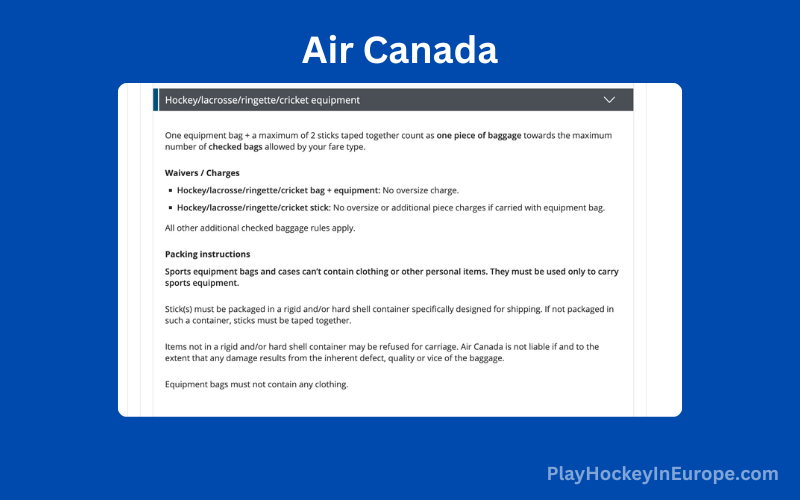
Ja toinen on Air Francen urheilutavarapolitiikasta jääkiekkovarusteille...

Kuten näette, ne ovat melko samanlaisia.
Se mitä tässä haetaan on sitä, että laskeeko lentoyhtiö pussit ja kepit yhteen, onko niillä keppiraja (joillakin on), ja saada järkeä, onko heillä reilu lätkämatkatavarapolitiikka.
Lyhyt vastaus = useimmat kunnolliset lentoyhtiöt tekevät
Kun huomaat, että he tekevät niin, ota siitä näyttökuva lentoyhtiöiden mukaan, joiden kanssa aiot lentää.
Miksi?
Koska joskus voi tapahtua (henkilökohtaisen kokemuksemme perusteella), että pakkaat kaikki jääkiekkovarusteet, pääset lentokentälle, ja lentoyhtiön henkilökunnan jäsen, joka kirjaa sinut sisään kyseisen lentoyhtiön tiskiltä, ei välttämättä tiedä omaa lentoyhtiöpolitiikkaansa tietylle urheilulajille.
Meidän tapauksessamme jääkiekkovarusteisiin.
He saattavat vain ajatella, että jääkiekkopussi ja mailat ovat kaksi erillistä tavaraa ja saattavat yrittää veloittaa sinua kaksinkertaisesti... tai saada sinut maksamaan ylimääräistä.

Jos sinulla on kyseinen kuvakaappaus tai tuloste, joka näyttää heidän käytäntönsä, olet helpottanut heidän viittaamista siihen.
Monelle suurelle lentoyhtiölle jääkiekkovarusteet lasketaan yhdeksi esineeksi kunhan noudatat heidän asettamiaan koko-/painorajoitussääntöjä. Jotkut lentoyhtiöt rajoittavat tikkuja, vaikka olemme löytäneet, kun taas toiset lentoyhtiöt ovat hieman löyhät täällä.
Käsittelemme hieman oikeiden lentojen ja lentoyhtiöiden valinnan tärkeyttä... mutta pidä yllä oleva mielessä, jos lennät XYZ Airlinea... katso vain urheiluvälineto-osiota, katso sivu, joka meillä on täällä, ja se auttaa sinua antamaan käsityksen siitä, lasketaanko se yhdeksi tuotteeksi.
Jääkiekkovarusteet/laukun paino
Toinen tärkeä osa, joka voi auttaa sinua säästämään kustannuksissa, on yrittää yhdistää jääkiekkopussi ja mailat painaa alle 50 kiloa (23 kiloa) ylimääräisen ylipainoisen matkatavaramaksun välttämiseksi.

Useimmille pelaajille (etenijä/puolustus), joilla on vakiopelaajavarusteet, laukku, jääkiekkomailat ja jopa lisää vähän ylimääräistä tavaraa yhdistettynä laukkuun mahtuu yleensä alle tuon 50lbs/23 kilon rajan.
Maalivahdeille varusteesi kokonaisuutena on usein hieman painavampi. Painorajaa työnnetään yleensä melko lähelle (tai yli), joten kannattaa ehkä pakata jääkiekkogitchisi tai ylimääräiset tavarat jääkiekkolaukkuun ja portata se toiseen matkalaukkuun välttääksesi ylimääräisen maksun.
Jos joukkue huolehtii matkoistasi, paino on tietysti hieman vähemmän tärkeä asia, mutta jos maksat siitä omasta taskustasi, nämä yllä olevat vinkit voivat auttaa sinua säästämään vähän rahaa... joten se on hyvä pitää mielessä varusteiden pakkaamisessa.

Muista: yritä vain pitää jääkiekkovarusteesi alle 50 kiloa (23 kiloa).
Helpoin tapa tehdä se on punnita varusteesi kotona tai kaverin vaa'alla (paikallisella kuntosalilla on todennäköisesti myös vaaka). Astu vain vaakalle nähdäksesi, mitä pussi painaa, ja sitten laitat pussin alas ja teet matematiikan eron siellä.
Viimeisenä vaihtoehtona, jos et löydä vaakaa etukäteen mistään, saavu lentokentälle muutama minuutti aikaisemmin ja vie varusteesi mihin tahansa matkatavaravaaaan, koska ne kaikki punnitsevat laukkuja. Se näyttää kuinka paljon se painaa. Sieltä voit liikkua muutamalla esineellä helposti ilman kiirettä ennen kuin siirryt päätarkastusjonoon kaikki matkatavarat kädessä.
Muutamia hyödyllisiä vinkkejä:
- pidä varusteesi mukavina ja järjestettyinä (esim. teippaamalla tikkuja yhteen jne.)
- merkitse kaikki jääkiekkomatkatavarat ja matkatavarat nimelläsi ja yhteystiedoillasi
- lisää hieman pahvia tai pehmusteita tikkujen päihin ennen teippaamista ne yhteen, jos sinulla ei ole tikkupussia - matkatavaroita heitetään vähän ympäriinsä etkä halua ilmestyä katkenneiden terien kanssa
- Varmista, että laitteesi ovat kuivia - yritä ennen lentämistä varmistaa, että laitteesi tuuletetaan tuulettamalla se edellisenä päivänä tai jos olet jäällä edellisenä päivänä, pidä se ulos hyvällä tuulettimella/kierrolla. Jos varusteesi on märkä, se voi helposti lisätä 5-10 kiloa pussin painoon
- Tarkista, milloin lentoyhtiö suosittelee sinua kirjautumaan urheiluvälineisiin - jotkut haluavat sinun tarkistavan urheiluvarusteesi 48-72 tuntia tai enemmän ennen, kun taas toiset voivat olla kunnossa samana päivänä lentokentällä.
Ei sillä, että olisimme käsitelleet kaikkea matkatavaroiden suunnittelusta... on aika tarkastella lentoyhtiöitä.
Lentoyhtiön valinta (kun matkustat jääkiekkovarusteiden kanssa)
Mikä on paras lentoyhtiö (t) valita, kun lennät jääkiekkovarusteilla?
Hyvä kysymys. Oikean lentoyhtiön valitseminen, kun matkustat jääkiekkovarusteiden kanssa, on erittäin tärkeää.
Ensisijainen nyrkkisääntömme tässä on Vältä erittäin erittäin edullisia kuljettajia hinnalla millä hyvänsä.
Ne vaihtelevat alueittain, mutta ajatellaan vastaavan Ryan Air/Wow Air Euroopassa tai Spirit/Frontier Airlinesia Pohjois-Amerikassa.
Et halua lentää näillä lentoyhtiöillä urheiluvälineillä. Ne ovat erittäin halpoja budjettilentoyhtiöitä syystä.

Jos nämä lentoyhtiöt pitäisivät kengurutuomioistuinta pukukopissa, he todennäköisesti yrittäisivät veloittaa sinulta 5 dollaria käsien venyttämisestä lennon keskellä... joten yritä välttää näitä lentoyhtiöitä kokonaan.
Emme myöskään kannata kalleimpien lentojen valitsemista... vain välttääksemme halvimmat lentoyhtiöt.
Kun matkustat jääkiekkovälineiden kanssa, kannattaa käyttää hieman enemmän vain vastuun vuoksi heidän urheiluystävällisen käytäntönsä suhteen matkatavaroiden kanssa. Sinulla on rennompi matka ja se on vain parempi kokemus kaikkialla.
Kun tiedät, mitä lentoyhtiöitä on vältettävä, säästät 80% päänsärkyistä.
Kun tämä on käsitelty, meidän on nyt puhuttava lentoyhteyksien tärkeydestä. Jatka lukemista...
Lentoyhteysaikojen merkitys
Jos lennät kansainvälisesti jääkiekkovarusteilla ja sinulla on ylimääräinen lento laskeutuessasi kyseiseen maahan, sinun kannattaa varmistaa, että sinulla on riittävästi aikaa ennen seuraavaa lentoa.
Tämä on ratkaisevan tärkeää kahdesta pääsyystä...
1) Ensimmäinen on jättää tarpeeksi aikaa jääkiekkopusseille, jotta he pääsevät seuraavalle lennolle.
2) Toinen on jättää aikaa passiin/maahanmuuttoon ja laukkujen tarkistamiseen, jos tarvitset sitä (jota käsittelemme myöhemmin tässä blogissa)
Lentojen välisessä osassa pyri aina jättämään itsellesi vähintään 2 tuntia lentojen välillä. Jos se on todella suuri lentokenttä (esim. Heathrow Lontoossa), saatat haluta jopa jättää hieman enemmän aikatyynyä.
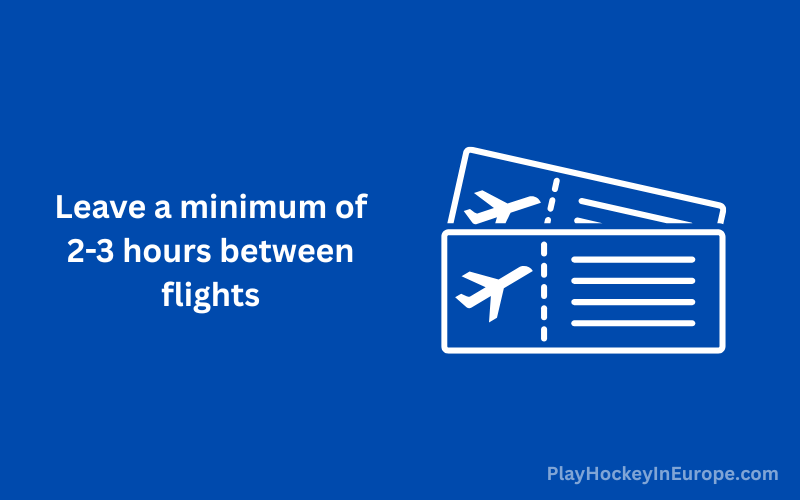
Jos lentosi on myöhässä, saatat pystyä pääsemään ajoissa (kävellen) kilpailujen/porttien läpi päästäksesi seuraavalle lennolle... mutta jos yhteys on liian lyhyt, on vähemmän todennäköistä, että varusteesi pääsevät liikkuvien laukkujen logistisen labyrintin läpi.
Se ylimääräinen ikkuna, jonka luot riittävän pitkällä yhteydellä, voi auttaa varmistamaan, että on todennäköisempää, että varusteesi pääsevät seuraavalle koneelle (päästäksesi lopulliseen määränpäähän).
Nyt on aika kävellä läpi, millaista on matkustaa kansainvälisesti jääkiekkovarusteidesi kanssa...
Matkapäivä (jääkiekkovarusteiden kanssa)
Sisäänkirjautuminen
Ensimmäinen asia on sisäänkirjautuminen. Prosessi on samanlainen kuin säännöllinen lähtöselvitys kuten millä tahansa muulla lennolla, mutta sinun on harkittava hieman enemmän, kun matkustat urheiluvälineillä.
Olemme jo käsitelleet muutamia asioita, joita voit tehdä ennakoivasti ennen jääkiekkoa valmistautuessasi... kuten punnitsemaan laukkusi ja varmistamaan, että otit kuvakaappauksen lentoyhtiösi urheiluvälinepolitiikasta jääkiekkovälineiden suhteen.
Saapuminen lentokentälle aikaisin
Se mitä haluat tehdä täällä on, että haluat saapua aikaisin. Haluat varmistaa, että koska sinulla on kokoisia laukkuja tai urheiluvälineitä, sinulla on ylimääräinen aika varmistaa sen todennäköisyys, että se pääsee koneeseen.
Jos normaalisti pääset sinne muutaman tunnin etuajassa turvallisuuden vuoksi, tee vain sama asia. Jos lentokenttä on todella kiireinen, leipoa ehkä hieman enemmän aikaa sisäänkirjautumista varten, jos jonot ovat pitkiä.
Kun kävelet sisäänkirjautumistiskille, ole ystävällinen ja kerro agenttille, että sinulla on jääkiekkovarusteet.
Jos hymyilet, olet kohtelias ja kerrot heille, jos sinulla on kuvakaappaus, jos he kysyvät ja sanot ”Hei, tämä lasketaan yhdeksi esineeksi”, he luottavat paljon enemmän tietäen, että se lasketaan yhdeksi esineeksi, koska käy ilmi, että olet matkustanut urheiluvarusteiden kanssa aiemmin.
Monta kertaa he tietävät sen, mutta kun muistutat heitä siitä (hymyillen), tekee siitä vielä todennäköisemmän.
Tuo kaikki matkalaukkusi kuten muillakin kansainvälisillä matkoilla, ja he joko keräävät kaikki laukkusi sinne tai joskus he pyytävät sinua pudottamaan urheilulaukun sivulle (koska se on suurempi esine), kun olet kirjautunut sisään.
Kaksi asiaa, jotka haluat tehdä:
- Varmista, että kaikki jääkiekkovarusteet on merkitty (lentokentän etikettien lisäksi, jotta he tietävät, mihin ne menevät). Varmista, että sinulla on selkeä etiketti, jossa on nimesi ja yhteystietosi siltä varalta, että jotain irtoaa (haluat pystyä tunnistamaan laukkusi myöhemmin)
- Jos he pyytävät sinua pudottamaan laukkusi sivulle, varmista, että joku siellä lataa sen kääntöpuolelle tai vie sen. Älä vain jätä sitä jonnekin olettaen, että joku hakee sen.
Kun jääkiekkovarusteet on kirjattu sisään, se on melko suoraviivaista. Käyt vain läpi normaalin prosessin, jossa käyt läpi lentokentän alkuperäisen turvallisuuden ja valmistaudut nousemaan koneellesi.
Kun saavut, seuraava osa on kätevä
Passin, maahanmuutto ja kansainvälisen laukun uudelleentarkastus
Jos lennät kansainvälisesti jääkiekkovarusteilla ja sinun on tehtävä jatkolento, sinun on tiedettävä passintarkastuksesta/maahanmuutosta ja laukkujen tarkistamisesta, kun laskeudut ensimmäiselle lentokentälle.
Yksi asia, joka todella yllättää monia pelaajia, kun he matkustavat ulkomaille jääkiekkovälineiden kanssa ensimmäistä kertaa, on esimerkiksi, että lentät mistä tahansa Pohjois-Amerikasta Eurooppaan ja lopullinen määränpääsi on Praha, Tšekki... mutta ensimmäinen lentosi laskeutuu Pariisiin, Ranskaan Charles de Gaullen lentokentälle matkalla Prahaan.
Kun laskeudut EU:hun kyseisellä lennolla, sinun on suoritettava passintarkastus/maahanmuutto... ja myös noudettava matkalaukkusi tarkistaaksesi ne uudelleen seuraavaa lentoa varten.
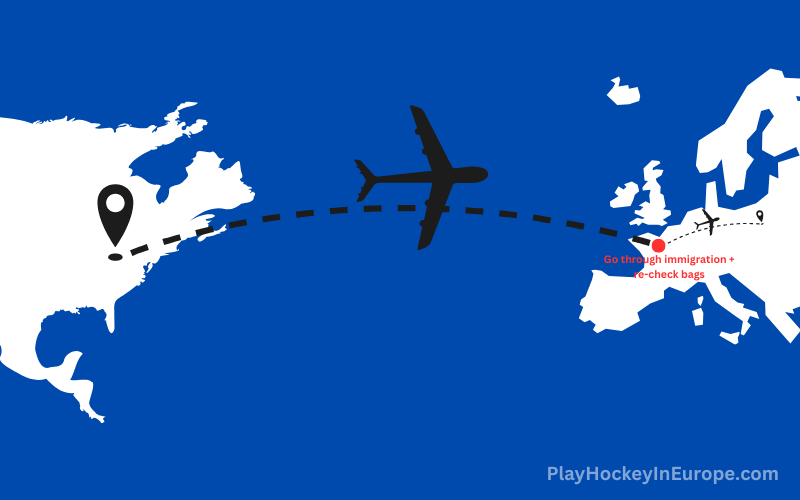
Tämä johtuu siitä, että olet laskeutunut uudelle alueelle (Eurooppa- Schengen-alue). Sinun on mentävä kunnollisesta sisäänkäynnistä - ja laukkujesi on läpäistävä turvatarkastuksen läpi ennen kuin jatkat.
Jos olet menossa Eurooppaan pelaajana, sinulla voi olla (tai ei) kiinteä sopimus joukkueelle, jonka kanssa pelaat, tilanteestasi riippuen.
Jos sinulla ei ole vielä sopimusta, se on hieno. Voit yksinkertaisesti todeta, että lennät ammattimaiselle jääkiekkokokeilulle tai lennät viimeistelemään sopimuksen joukkueen kanssa. Sinulla on 90 päivän viisumivapaus matkustaa Schengen-alueella, jos olet pelaaja Pohjois-Amerikasta.
Passi leimataan ja jatkat useimmissa tapauksissa...

Kun olet käynyt läpi tämän yllä olevan prosessin, olet taas lentokentällä odottamassa seuraavaa lentoa (lentoja). Jos lennät vain yhdellä lennolla, kuten saavut Tukholmaan, Berliiniin jne., ja se on lopullinen määränpääsi, olet valmis tähän osioon.
Niille teistä, jotka lentävät Eurooppaan yhdellä lennolla ja jatkat sitten toisella lennolla lopulliseen määränpäähän (kuten on yleistä), haluat vain pitää tämän mielessä, koska se lisää hieman ylimääräistä aikaa.
Tämä on toinen ensisijainen syy, miksi suosittelemme jättämään useiden tuntien vähimmäisvälin lentojen välillä, kun lennät yli ja sinulla on ylimääräinen lento.
Laskeutuminen + jääkiekkovarusteiden noutaminen
Seuraava osio kattaa saapumisen jääkiekkokohteeseesi.
Kun vihdoin saavut lopulliselle määränpäällesi lentokentälle, on aika noutaa jääkiekkovarusteet.
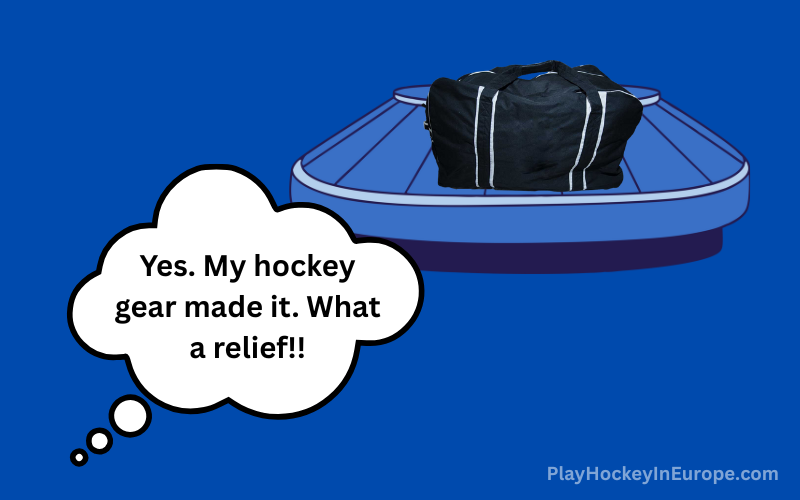
Joskus jääkiekkovarusteet tulevat pyörimään matkatavarakarusellilla. Muina aikoina, koska se on hieman suurempi erikoismatkatavara, jääkiekkolaukkusi tai mailasi eivät välttämättä rullaa matkatavarakarusellin ympärillä kaikkien muiden matkatavaroiden kanssa.
Älä ihmettele, jos joudut menemään ylisuuriin tavaroiden noutoon, joka saattaa olla erillisellä alueella. Se voi vain olla matkatavarakarusellin puolelle, josta laukut noudetaan.
Jos odotat vähän ja olet epävarma, kysy joltakin lentokentällä työskentelevältä ja kysy: ”Hei, haen suurempia urheiluvälinepusseja. Poiminko tuon täältä vai pääseekö se erilliselle alueelle? Jos on, niin missä se on?” Yleensä he osoittavat sinut oikeaan suuntaan siitä, mistä poimit sen.
Toivottavasti varusteesi saapuvat ajoissa. Jos ei kuitenkaan, haluat tietää mitä tehdä
Seuraava osio kattaa tämän puolestasi, jotta tiedät mitä tehdä siltä varalta, että varusteesi viivästyvät.
Mitä tehdä, jos jääkiekkovarusteet viivästyvät
Jos jääkiekkovarusteesi viivästyvät jostain syystä saapuessasi lopulliselle lentokentälle, sinun kannattaa tehdä korvausvaatimus ennen lähtöä lentokentältä.
Useimmissa tapauksissa varusteesi pääsevät sinne korkeintaan tunneista muutamaan päivään.
Jos saavut, mutta varusteesi eivät saavu, on aina hyvä tarkistaa, että jääkiekkovarusteet eivät saapuneet vain lentokentän eri osaan. Joskus tässä on jonkin verran hämmennystä, jos lentää eri alueelle ja englanti on toinen kieli ihmiselle.
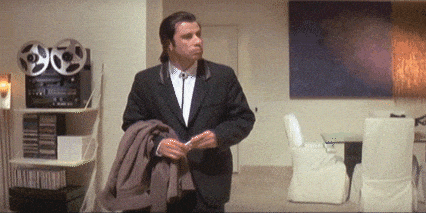
Jos jääkiekkovarusteesi eivät kuitenkaan saavu, mikä voi tapahtua joskus jääkiekkovarusteiden kanssa, kun teet useita lentoja, sinun kannattaa antaa yksityiskohtainen kuvaus laukusta, jääkiekkolaukun väristä, minkä tyyppisestä laukusta se oli, ja mikä tahansa muu kuvaus, joka auttaa antamaan yksityiskohtia.
Sieltä haluat saada heiltä viitenumeron ja matkatavaroiden seurantatiedot varmistaaksesi, että he noudattavat osaltaan matkalaukkujen toimittamista sinulle.
Kun olemme kokeneet tämän itse entisinä pelaajina, olemme huomanneet, että kohtelias, mutta sitkeä oleminen on paras tapa tässä.
Jotain seuraavan linjan ilmoittamista on hyödyllistä käyttää:
”Urheilulaukkuni eivät ole vielä saapuneet, mutta minulle on todella tärkeää, että minulla on ne huomiseen mennessä.”
Haluat olla rauhallinen ja selvä ”Hei, tarvitsen tätä huomiseen peliin” tai ”Harjoitussessiota huomenna”, vaikka se olisi pari päivää ulkona. Haluat olla sinnikäs heidän kanssaan, jotta he voivat yrittää olla avuksi auttaakseen sinua saamaan jääkiekkolaukkusi mahdollisimman nopeasti.
Kun olet ystävällinen ja kosket sitä, kuinka tärkeää on saada varusteesi mahdollisimman pian urheilua varten, he haluavat toivottavasti yrittää parhaansa (hallussaan) saadakseen ne sinulle mahdollisimman nopeasti, kun ne saapuvat... olipa se sitten viemässä ne sinulle seuraavana päivänä tai he lentävät sen lopulliseen määränpäähäsi sanovat, että nouset junaan samana päivänä kaupunkiin, jossa joukkue sijaitsee.
Johtopäätös
Yhteenvetona voidaan todeta, että tärkein asia, jonka voit ottaa pois, on vain ymmärtää, että kansainvälisesti matkustaminen jääkiekkovälineilläsi on vähemmän stressaavaa, kun tiedät sen säännöt.
Kun olet jo lukenut kaikki nämä... sinulla on nyt iso jalka ymmärryksessäsi... perustuen vuosien kokemukseemme sen läpi käymisestä ja puhumisesta lukemattomien pelaajien kanssa.
Hyvällä suunnittelulla, ajoituksella ja hyvällä pakkaamisella asetat itsesi parhaaseen asemaan saadaksesi hyvän lentokokemuksen kaikkialla. Ja tiedät myös, mitä tehdä muutamassa pahimmassa tapauksessa (viivästyneet laukut) tilanteissa.
Toivomme, että tämä viesti oli hyödyllinen, ja jos olet pelaaja (tai autat sellaista) ja olet motivoitunut pelaamaan ulkomailla Euroopassa, voimme olla potentiaalinen resurssi sinulle auttaaksemme sinua pelaamaan seuraavalla tasolla. Kerro meille mukavan viestin Esittele itsesi ja kerromme sinulle, jos voimme auttaa.
